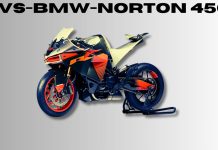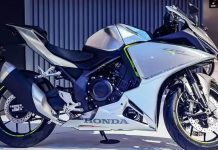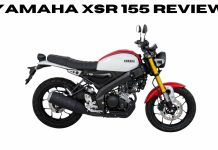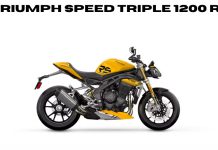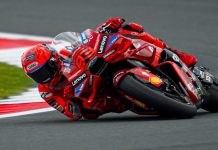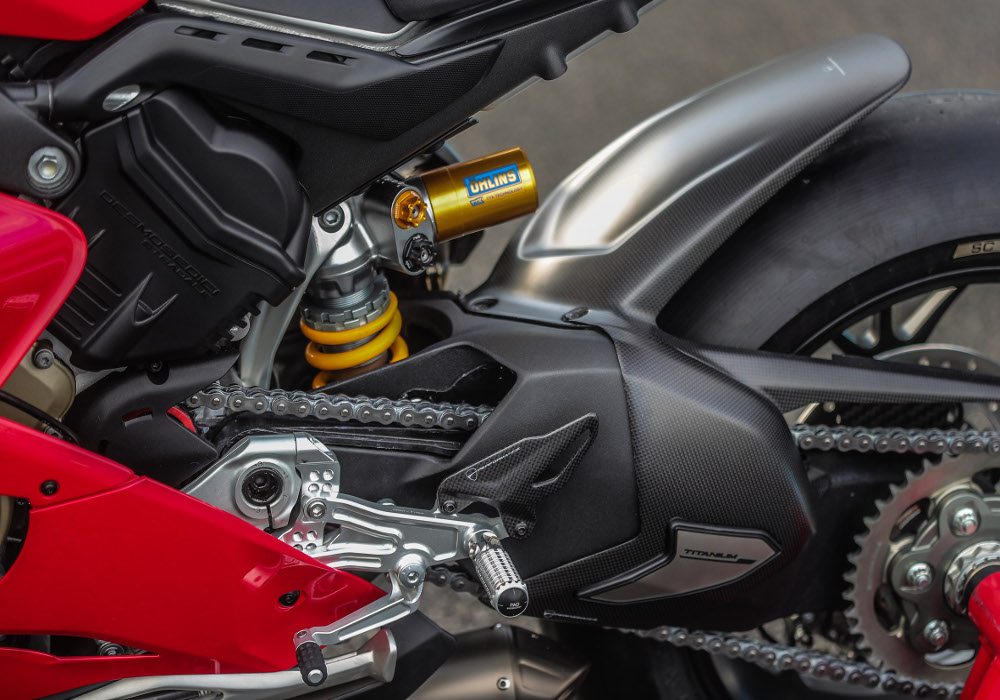The Panigale V4 R is the ultimate road-legal Ducati race bike. Compared to the previous R version, the Panigale V4 R is even more specialised. The modifications extend far beyond the engine and suspension set-up: for the first time they also include an Aero Pack designed directly by Ducati Corse in close collaboration with the Ducati Style Centre to improve on-track aerodynamic efficiency.
The Panigale V4 R is a road-legal WSBK category racing bike and constitutes the technical platform for the official Ducati Superbikes that will compete in the 2019 season. The new Panigale V4 R merges the essence of the Panigale V4 S with the specific changes requested by Ducati Corse to make it race-competitive.
The 1,103 cm3 90° V4 engine has been replaced with the 998 cm3 Desmosedici Stradale R which brings it within the displacement limits established by WSBK championship rules. The bike features a new fairing incorporating wings elements of MotoGP origin. It also has race-grade Öhlins suspension with mechanical adjustment and an aluminium swingarm with an adjustable four-position axle. Moreover, the Front Frame has been modified to achieve the stiffness targets set by Ducati Corse.
Sophisticated electronic controls borrowed from the Panigale V4 S now have revised threshold levels to make them more compatible with pro rider requirements. Unlike the 1,103 cm3 Desmosedici Stradale, designed to provide fluid power delivery and excellent low-rev pulling power for optimal road use, the 998 cm3 Desmosedici Stradale R version offers more extreme performance as power delivery has been designed with the track in mind.
The Desmosedici Stradale R features lighter internal components and greater air intake efficiency: this allows faster engine rev-up and shifts the rpm red zone higher to improve acceleration. The result is 221 hp (162 kW) of power – which responds instantaneously to throttle movements – at 15,250 rpm (EU homologation values), 2,250 rpm higher than on the 1,103 cm3 V4.
As in MotoGP, where all that matters is maximum performance, the Panigale V4 R features a dry clutch. This gives greatly improved ‘feel’ during braking and through the corners, allows personalisation of the degree of ‘mechanical’ engine braking and is characterised by that iconic mechanical rumble which Ducati fans find irresistible.
It’s not just the racing-inspired livery that makes the Panigale V4 R unmistakeable. An eyecatching aerodynamics package requested by Ducati Corse includes screen, nose fairing and side fairings to reduce drag. It also features specially shaped air vents to reduce working temperatures during intense racing use. GP16-derived carbon fibre wings augment stability at all times, reducing electronic control intervention and boosting rider confidence, helping him keep the throttle open longer and brake later going into the corner.
The suspension system has been optimised for track use. Both the steering damper and the Öhlins suspension mount mechanically adjustable top-drawer com. More specifically, the brand new pressurized NPX 25/30 front forks take as-standard Öhlins components to new heights. The rear TTX36 shock absorber completes the package.
Desmosedici Stradale R engine
The Desmosedici Stradale R – the link between the 1,103 cm3 V4 on the Panigale V4 and the MotoGP engine – takes the performance limits for a road-legal engine to unprecedented heights. Originally designed to compete in the Superbike championships, this engine has now undergone numerous changes that make it even more like the one used in MotoGP.
The Panigale V4 R engine can deliver 221 hp (162 kW) at 15,250 rpm and 112 Nm of torque at 11,500 rpm (EU homologation values). It has a 14:1 compression ratio and the rev limiter is set at 16,000 rpm (16,500 rpm in sixth gear). These figures – impressive for a 998 cm3 engine – can be taken even higher by fitting the full-racing Ducati Performance exhaust by Akrapovič, which boosts maximum power to 234 hp (172 kW) at 15,500 rpm. Like the Desmosedici Stradale, the R version is a 90° V4 with cylinders banked 42° back from the horizontal, a Twin Pulse firing order and a counter-rotating crankshaft
Designed to be a fully stressed member of the vehicle, the engine retains a bore of 81 mm while stroke has been changed to 48.4 mm thanks to the new forged steel crankshaft which moves four titanium con rods with a centre-to-centre of 104.3 mm: each one is 100 g lighter than the steel ones used on the Panigale V4.
Pistons are made of moulded aluminium, have a single compression ring plus an oil ring and take advantage of “box in box” technology: this contains both skirt height and below-chamber thickness, helping to reduce attrition and inertial loads while maintaining the necessary strength and stiffness.
Featuring dedicated profiles, the four Desmosedici Stradale R camshafts provide increased lift with respect to the Desmosedici Stradale and move the sixteen valves (Ø 34 mm titanium intake valves, Ø 27.5 mm steel exhaust valves). The valves feature titanium half-cones, a solution usually adopted only on racing bikes. Dedicated fluid dynamic design of the R engine cylinder heads has led to the development of new, larger intake ducts.
The new crankshaft – 1,100 grams lighter than the one on the Panigale V4 – is mounted on brass bushings and retains the 70° crank pin offset together with the 90-degree V engine layout. This solution generates what Ducati calls a Twin Pulse firing order, because it’s as if the engine were reproducing the firing sequence of a twin-cylinder. The distinctiveness lies in the fact that the two left-hand cylinders fire closely together, as do the two right-hand ones. On the timing chart, the ignition points are, then, at 0°, 90°, 290° and 380°. This particular firing order makes the V4 sound just like the MotoGP Desmosedici.
The Desmosedici Stradale R engine gulps in air through oval throttle bodies and aerodynamic throttle openings (Ø 56 mm equivalent, an increase of 4 mm) connected to variable-height air intake horns of dedicated length. This solution optimises cylinder intake across the rev range, giving major advantages in terms of power delivery and handling.
Thanks to development in close collaboration with Ducati Corse, the R version of the Desmosedici Stradale engine has undergone numerous performance-enhancing improvements. To limit power absorption the oil delivery pump has been redesigned and the alternator rotor lightened, shaving another 100 grams off total bike weight.
* This layout demands the addition of the so – called ‘jackshaft’ to transfer crankshaft drive through the gearbox to the rear wheel so it turns the right way. The jackshaft adds an extra transmission n element to the crankshaft – wheel connection system. This needs to be taken into consideration when establishing crankshaft power if the latter is obtained from measurements made at the wheel. During both homologation and measurement on acceleration test b enches it is, therefore, necessary to consider an efficiency or, in any case, an additional coefficient that is, by law, fixed at 0.98.
“Dry clutch As in MotoGP, where all that matters is maximum performance, the Panigale V4 R features a dry clutch. The V4 R mounts an STM EVO – SBK clutch, made of machined – from – solid aluminium with a 48 – tooth clutch basket and plate set; there are 9 take – up plates and 9 drive plates with a diameter of 138 mm.
During extreme on – track use, this gives greatly improved ride ‘fee l’. More specifically, the dry clutch ensures a more efficient anti – patter function, even during aggressive downshifting, and greater fluidity during ‘off – throttle’ phases; moreover, it’s also possible to personalise the degree of ‘mechanical’ engine braki ng by selecting a different secondary spring from those available in the Ducati Performance accessories catalogue. “.
Further benefits include the absence of the resistance opposed by the engine oil and reduced oil contamination as dust from disc wear is not c arried into the lubrication cir c u it.
Last but not least, there’s the iconic mechanical clutch rumble which Ducati fans find irresistible.
Aero Pack by Ducati Corse
The aerodynamic Panigale V4 R ‘shell’ was developed by Ducati Corse in close collaboration with the Ducati Style Centre; the outcome is a fairing in true Panigale style that meets official Ducati Superbike needs in full. As in MotoGP, aerodynamic development involved a series of preliminary CFD (Computational Fluid Dynamics) studies, followed by optimised shaping of a full-scale wind tunnel model.
The Panigale V4 R aerodynamics package includes: • Screen, nose fairing and larger lateral fairings • More efficient lateral vents for radiator through-air • Wings
Compared to the Panigale V4, the new screen – higher and more angled – provides better airflow protection for riders, especially in the helmet and upper shoulder areas. The screen is attached to a new nose fairing that is higher and wider (+15 mm per side) in the arm-shield zone in order to reduce arm and shoulder-induced drag on the straights.
The lateral fairings have been widened considerably (+38 mm per side) with the dual aim of reducing on-rider airflow impact and maximising aerofoil efficiency.
At the sides, the stylish air vents of the Panigale V4 have been replaced by more efficient ones designed to handle the racing-type temperatures reached by the more powerful engine on the Ducati Panigale V4 R. These new vents increase air through-speeds on water and oil radiators by 6% and 16% respectively. The biggest change on the Panigale V4 R – which defines the aesthetics of the bike – comes from the wings. Conceptually derived from those used on the GP16 (before aerofoil shapes were subject to regulatory limits), the ‘wings’ on the Panigale V4 R are actually more efficient than those employed in MotoGP.
These monoplane single-element wings have a trapezoidal layout with a tapered profile from root to tip. Wing performance has been improved thanks to the insertion of the longitudinally arranged strake and the winglet which ‘insulates’ the airflow over its surfaces.
Working in concert with the fairing design, the wings increase overall downforce (+30 kg at 270 kph). Greater downforce reduces front wheel ‘floating’ at high speed and the tendency to wheelup; it also boosts stability during braking at the turn-in point and through the corner. This dynamic behavior lets riders – against a small increase in steering torque caused by the heightened stability – lower their lap times as it reduces electronic control intervention.
Source : Ducati



